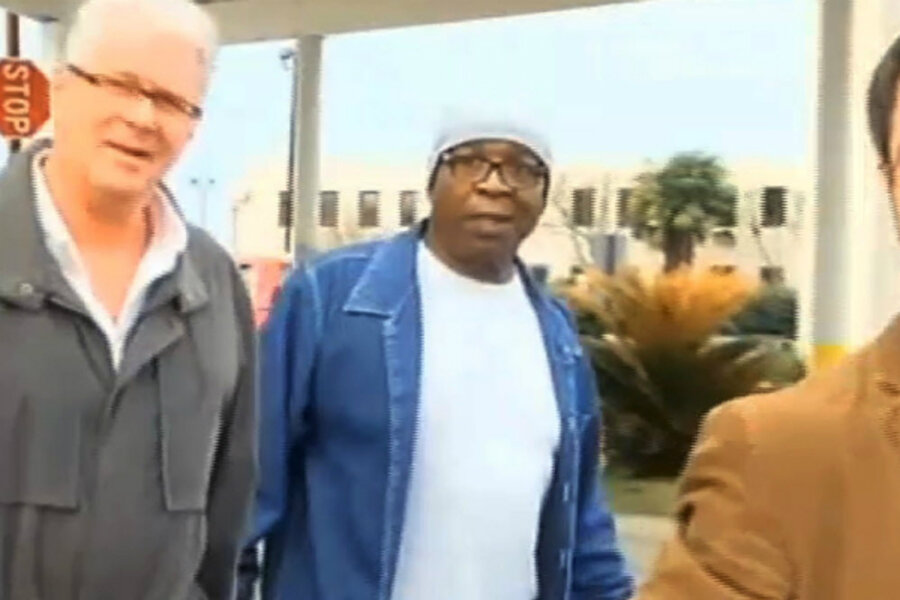Death row inmate, wrongfully convicted, goes free almost 30 years later
Loading...
Glenn Ford, sentenced to death nearly three decades ago for shooting a man whose lawn he used to mow, was not even at the scene of the crime, according to new evidence used to free him from prison this week.
Mr. Ford, Louisiana’s longest-serving inmate on death row, was released from prison Tuesday, after prosecutors told a local judge that new evidence from a confidential informant proved that Ford had not committed the crime for which he was sentenced to death, local news outlets reported.
Ford, held in Louisiana’s Angola prison since March 1985, had been convicted in large part because prosecutors had suppressed evidence at trial that would have proved Ford’s innocence – and pointed at another suspect. His capital murder case was also riddled with flawed expert testimonies and fumbled by inadequate counsel, his attorneys said in a news release.
“In late 2013, credible evidence came to the attention of the undersigned to supporting a finding that Glenn Ford was neither present at, nor a participant in, the robbery and murder of Isadore Rozeman,” reads the March 11 court filing by prosecutors.
Ford is one of a slew of inmates who have been exonerated in recent months, amid growing recognition that the justice system is not foolproof and that innocent people can, and do, go to prison. Last year, some 87 people convicted of crimes they didn’t commit were exonerated, a record high since the National Registry of Exonerations began tracking wrongful conviction numbers in 1989.
So far, 19 people, not including Ford, have been exonerated in 2014, according to the registry, which is a joint project of the University of Michigan Law School and the Center on Wrongful Convictions at the Northwestern University School of Law.
Ford’s story dates back to Nov. 5, 1983, when Mr. Rozeman, a watchmaker, was found shot to death behind the counter of his jewelry, china, and silverware shop in Shreveport, a northern Louisiana city hard to the Red River, according to the court filing.
Ford, who did yardwork for Rozeman, was called to the police station for questioning after the murder. He told investigators that he had visited Rozeman on the day of the shooting to ask for work, but had been told there was none.
Ford also told police that he had talked that day to a man whom he knew just as “O.B.” and who he said had given him some jewelry to pawn. Receipts later showed that the jewelry Ford pawned on O.B.’s behalf matched items stolen from Rozeman’s shop.
Ford later identified O.B. as Henry Robinson, the brother of a local man named Jake Robinson. Jake’s girlfriend, Marvella Brown, implicated both brothers in the murder, and the Robinsons became the police’s main suspects in the case, according to the Capital Post Conviction Project of Louisiana (CPCPL), which handled Ford’s appeals.
But Ms. Brown, in a fateful statement for Ford, also told detectives that Ford had been with the brothers. Ford, too, became a suspect, and the Shreveport District Attorney’s Office issued indictments for all three men.
Brown, under questioning, later recanted what she had told police, telling the jury that she “lied about all of it,” according to CPCPL. It was too late for Ford, though. Based on the testimony of three forensic experts, Ford was singled out from the pool of three suspects as the murderer.
Ford, who is black, was found guilty and sentenced to death by an all-white jury. He has maintained his innocence ever since, according to CPCPL. The Robinsons were found not guilty.
In a series of appeals, defense attorneys showed that the original prosecution had suppressed evidence during the trial that corroborated Ford’s innocence claims, including a police report that had two informants saying that Jake Robinson had committed the murder, as well as evidence that the Robinsons were in possession of the murder weapon after the killing.
Post-conviction counsel also called experts who testified that the expert testimonies given at trial were grossly inaccurate. Ford’s two lawyers, neither of whom had ever defended a client before a jury and had either limited or no experience in criminal law, had not called any expert witnesses for the defense at the original trial.
Still, Ford stayed in prison even after the Louisiana Supreme Court wrote – in an opinion upholding his conviction – that the evidence against him was “not overwhelming” and the case against him was open to “serious questions,” according to CPCPL.
It was not until March 11, when district prosecutors wrote to a district judge that a confidential informant had told them in late 2013 that Jake Robinson was the murderer, that Ford was exonerated.
Over the past 25 years, almost 60 percent of the wrongful convictions for homicide in the United States have been associated with official misconduct, including the suppression of evidence, according to the National Registry of Exonerations.
About 8 percent of exonerations since 1989, or about 105 inmates, have been of people on death row, even though just about 1/100 of 1 percent of felony convictions are death sentences, according to the National Registry of Exonerations.
For the past decade, there has been an average of three death row exonerations per year, the registry says.






